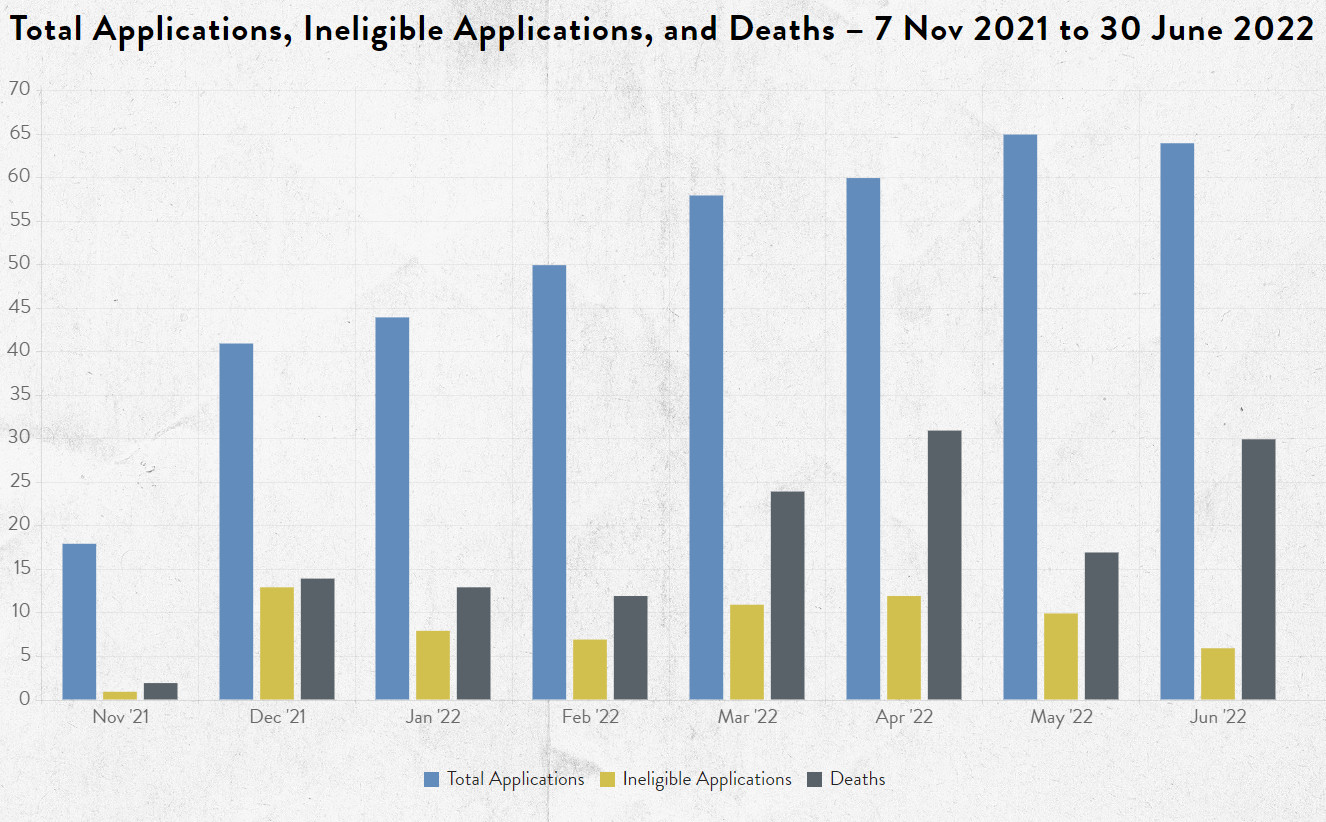It has now been almost ten months since the practice of assisted suicide and euthanasia began in our country, and recently the first official reports were published detailing what has happened in New Zealand over that period.
A recent press release by DefendNZ analyses these reports, which DTNZ has published in full below.
The first of these official reports came in June with the Registrar (assisted dying) Annual Report to the Minister of Health, and then in July the Ministry of Health (MOH) posted its latest quarterly data to the Assisted Dying Service Data and Reporting section of its website.
Before we explore the details of what this reporting has revealed, we think it is important to point out that our data collection requirements are still seriously lacking in key areas.
Unlike overseas jurisdictions, for example, we are not reporting on the reasons being given by people seeking euthanasia or assisted suicide.
This is a major oversight, as this particular data point offers us the opportunity to spot dangerous trends in the practice of assisted suicide and euthanasia and take proactive steps to ensure such things don’t continue unchecked.
This is why one of our Six to Fix amendments is seeking a change to the current End of Life Choice Act to require a much-needed improvement in data collection and reporting.
MOH Assisted Dying Service Data and Reporting update
The reporting on the MOH website covers the period of euthanasia and assisted suicide from 7 November 2021 to 30 June 2022, and it reveals the following facts:
- 143 people were killed by euthanasia or assisted in their suicides
Although the MOH doesn’t provide a specific breakdown for the two methods, the Registrar (assisted dying) Annual Report to the Minister of Health in June revealed that approximately 85% of people are being euthanised, and 15% ending their lives by assisted suicide. - Another 44 people had been approved but had not yet been euthanised, or carried out their assisted suicide
The MOH reporting also revealed that 400 people had applied for euthanasia or assisted suicide, and that:
- 187 were approved (143 of these had been carried out already)
- Another 57 were still under assessment for eligibility
- Another 62 had died before their application had finished being processed
- Another 23 had withdrawn from the process (no reasons cited)
- Another 68 were deemed ineligible and declined (17% of total applicants)
Three concerning factors come to light in the MOH report
Most alarmingly of all, the MOH indicates that only 3 of these 400 people were referred for a psychiatric assessment.
What this means is that less than 1% of all the people who asked to have their lives ended were referred for the important protective mechanism of a psychiatric assessment.
If all of these three people were subsequently approved, this means that less than 2% of all euthanasia and assisted suicide cases have been assessed to try and ascertain that they were free from mental health issues.
The MOH also reveals the troubling fact that 1 in 5 applicants (21%) were NOT receiving palliative care.
This raises serious issues about whether their request would have even been made had they been receiving proper end-of-life care.
The other important thing that the MOH report reveals is that the trend for euthanasia and assisted suicide is heading in an upward direction.
As you can see from their official graph below, despite a dip in May, the trend line is heading in only one direction.

Data from MOH. A total of 400 applications have reported over this period. Of these 68 applications were deemed ineligible, and 143 people died by assisted suicide or euthanasia. What is additionally disturbing when overlaying these, is that while applications are dramatically rising, those rejected due to ineligibility is disproportionately decreasing. An interactive version of this chart is available here.
Based on brand new data from Statistics NZ, there will be one million people over 65 years of age in our country by 2028 – an increase of approximately 160,000 from the current numbers.
The fact that the overwhelming majority of NZ euthanasia and assisted suicide cases have been in this same demographic (which is consistent with the overseas trend) means that an increase in numbers is inevitable.
Only half of last year’s $176 Million Hospice NZ budget was government funded – meaning they had to fundraise the other $88 million to cover their 32 hospices around New Zealand.
Not only is this not meeting the current need, with gaps all over the country, but the problem is only going to get worse with the NZ demand for palliative care expected to almost double over the coming decades.
When you consider that the MOH has six full-time positions dedicated to euthanasia and none to palliative care, it doesn’t take a rocket scientist to see how this will play out very badly for a lot of New Zealanders.
The Registrar (assisted dying) Annual Report beats the drums of expansion
Several things are striking about the Registrar (assisted dying) Annual Report to the Minister of Health that was published in June.
Firstly, the sparseness of the information provided in that report highlights just how inadequate the reporting requirements are in the End of Life Choice Act.
This is particularly apparent in the brief sections highlighting complaints (pages 23 & 24), where key information providing important specifics about these complaints is noticeably absent.
The second striking thing about this report is that it is already beating the drums of euthanasia expansion.
On page 14 it highlights that, for some aged care providers, “allowing assisted deaths within its facility may be a complex decision due to differing viewpoints within the organisation.”
It then goes on to state that (emphasis added):
“The Secretariat continues to support and encourage providers to consider how to support person-centred access to assisted dying should a person in a provider’s care request assisted dying.”
We can’t help but wonder if this is an attempt to put objecting care providers on notice that their refusal to allow euthanasia and assisted suicides to be carried out in their facilities is both frowned upon, and may even be legislated against in future.
The most unabashed cheerleading for euthanasia expansion is found on page 25 of the report, which provides this summary of feedback that has been received (emphasis added):
“The legislation is welcome, and applicants were relieved that this service is available. The legislation is not as enabling as some people were hoping for with the criteria making an assisted death more restrictive than overseas jurisdictions. This was coupled with hope for a broadening of criteria over time.”
Another notable aspect of this report is the glaring lack of the original feedback sources, even as an appendix. All we are provided is a very brief summary, which leaves us with no way to tell whether other important issues raised in feedback have not been revealed in this report.
The most alarming thing of all in this reporting
One of the most shocking aspects of the Registrar (assisted dying) Annual Report is found on page 3 of the report when they state that New Zealand will be using ‘mate whakaahuru’ as the te reo Māori translation for euthanasia and assisted suicide.
In Maori, this translates as: ‘to die in a warm and comforting manner’.
Not only does this translation fail to accurately describe the practice of euthanasia or assisted suicide – let alone ‘assisted dying’ – but it is blatantly motivated by ideology rather than truth.
This phrase ‘to die in a warm and comforting manner’ doesn’t actually describe euthanasia or assisted suicide, instead, it tells people how they should think, feel and believe about euthanasia and assisted suicide.
To see this level of blatantly dishonest propagandistic language being employed for what should be a purely technical and honest description of a particular practice is extremely worrying.
This does not bode well for the impartiality of those tasked with overseeing euthanasia and assisted suicide in our country.
The data reinforces the urgent need for amendments to the End of Life Choice Act
When all is said and done, this first round of reporting about euthanasia and assisted suicide confirms the case that #DefendNZ has been making for many months now.
There are clearly some very troubling safety, transparency and accountability flaws in the End of Life Choice Act which need urgent attention.
The only way to hope for any improvement is for amendments, like our Six to Fix, to be made to the Act so that the harmful impact of this legislation on vulnerable New Zealanders is lessened.

At least the euthanasia’s still voluntary (for now)…